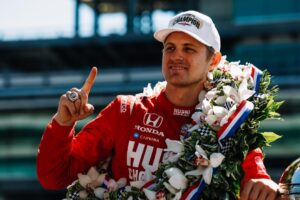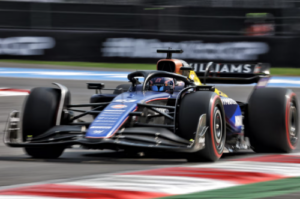From a disadvantage of developing a brand new car at the start of the season, the ZB Commodore showed in North Queensland how they are now holding a speed advantage at WatPac Townsville 400.
ZB Commodore holds speed advantage at WatPac Townsville 400
They; being Red Bull Holden Racing, were demonstrably faster than every other team. Ever since the opening stages of Race 17 when Scott McLaughlin led the race, both of the Holden ZB Commodores have shown superior performance.
That resulted in a 1-2 finish in the Saturday race; Jamie Whincup over Shane van Gisbergen. And coincedentally for Whincup a 10th victory over the ten years which the Townsville street circuit has been a part of Supercars.
🖐️🖐️
That's 10 victories from 20 races in Townsville for @jamiewhincup. Welcome back to @VirginAustralia Victory Lane. #VASC pic.twitter.com/YCDCVwYnBD
— Supercars (@supercars) July 7, 2018
After winning the Saturday race, the Red Bull team put their machinery at the head of the field for Sunday. The bounce-back from the poor qualifying runs of late, had seen the outcome which team principal Roland Dane has been asking for. A great turnaround was provided by drivers and engineers, with the ZB Commodore now having the better of the Falcon on the track.
Having to sit behind the Ford Falcon FG X of series leader Scott McLaughlin for much of the year, that was redressed on Saturday soon after the flag dropped. Since then, Red Bull was never headed. DJR Penske Racing tried hard to regain lost pace, but the ZB Commodore was dominant.
Is it a complete change for the championship? No, that would be hard to judge after Townsville. But the action on Sunday proved how the speed and good strategy now favoured the ZB set-up; who looks to have remedied the problem that 888 Racing had found with the new Holden Commodore design distributed to several leading teams.
Van Gisbergen suffers ‘Under Cut’ in 1st pit stop
On Sunday, by staying out for extra laps, that managed to do two things in the Red Bull Holden garage. It separated the two cars; so they did not have to compete for a pit stop place. And – in Whincup’s advantage to begin with – was to put the title holder initially into first. An example of how the much discussed ‘under-cut’ factor applied.
That is; when cars pit early whilst in heavy traffic, to gain clean air. And then, as the cars extend space between each other, before (the car which was ahead of them) does stop – an advantage occurs. If the tyres are fresher [at that stage] then the earlier car to pit, gets minute advantages while the leading car slows fractionally over a number of laps.
Scott McLaughlin tried to ‘roll the dice’ earlier than any other team actually. Although, as soon as Whincup pitted, he halted what early gain DJR had established. But van Gisbergen waited. And he waited. There were four laps before the #97 car pitted – that meant he came out after McLaughlin on the track. And critically at the time, well behind Whincup due to the under-cut effect.
SVG still yet to pit, at this stage it appears he would be undercut by Whincup, however running longer gives him the rubber advantage#VASC
— TheSupercarsCollective (@VASC_Collective) July 8, 2018
While staying out longer gave the Kiwi driver a small amount of favourable tyre life later, it didn’t seem to translate in the second stint immediately. He had to run harder, but it would help him [as it had done for others in previous rounds] before long, as the final racing pit-stops occurred.
More and more today, the positioning of the final pit stop is critical to success. When it comes down to teammates, it is even more important. So as van Gisbergen had suffered from an under-cut early, he in fact held a better volume of fuel, ahead of Whincup. In fact, after 45 laps out of the 70 lap race, van Gisbergen managed to erode the under-cut advantage.
Yellow Card compresses field in final Laps
When Michael Caruso ended his race into the Dunlop safety-tyres, he caused a late bit of excitement for the race field.
This is typically what happens when the field squeezes up after a restart, you get action!
It affected many drivers. There was contact between several cars, with Will Davidson ending a good performance too early. But who it ‘did not affect’ were the leading ZB Commodore drivers.
Shane van Gisbergen led the field, with Whincup right on his axle. Both escaped any drama, with the soon-to-be-retiring Craig Lowndes mounting a late challenge on the #17 Shell V-Power Falcon. It appeared that the Triple 888 Racing engineers could even sew-up the top three places, until McLaughlin was able to hold back the four-time Bathurst winner.
https://twitter.com/supercars/status/1016121029134036992
Championship Stakes – 30 point gain for van Gisbergen
“Second stint, the car came good” was the explanation from race winner Shane van Gisbergen on his success. That might have explained his elation, after only two race wins so far in 2018. But he was able to convert an “evolution of the qualy-set up” into a third 2018 Virgin Australia Supercars Championship race win.
Maybe that’s why we saw his infamous burn-out deliver more entertainment for the Townsville crowd.
He enjoyed that one… SVG P1 and J-Dub P2! Lowndesy came through P4 🙌👊 #vasc #redbullholden pic.twitter.com/x6NnTKYgrN
— Red Bull Ampol Racing (@redbullampol) July 8, 2018
“I’m just happy we were genuinely up there in qualifying. Be quick in every sector of qualifying, that is the secret”, was the verdict when SVG was asked about ‘what was the secret’ to winning.
It is still too early to judge if the 30 point gain from van Gisbergen will be a tipping point. But what is known is that entering the last few rounds, including the ‘Enduro-rounds’ that will reward drivers with up to 300 competition points, is a shifting point.
So, good results from now until Bathurst, can really help your title chances.
After the WatPac Townsville 400, at least the fans will be happy with that burnout performed by ‘Gizzy’. He sure knows how to leave the race fans happy on a Sunday afternoon.
MAIN PHOTO:
Embed from Getty Images






